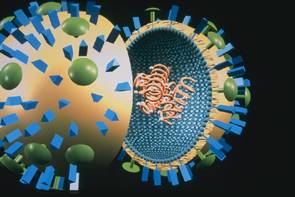• General
knowledge about viral components can be combined with (in our case) general
separation techniques to come up with clever, economically viable products
References:
(1) V.S. Ramachandran, M.D., PhD., and Sandra Blakeslee. 1998. Phantoms
in the Brain. New York: William Morrow.
Main Topic - Overall Assessment:
VIRUSES

(Image from www.handpen.com/Bio/medical.htm,
2003)
Working through this module should have given students a sense of how a
scientist might study a single organism or problem from many different angles,
using whatever available tools to answer the question at hand. Hopefully
students will have noticed that each approach is carefully planned, designed
to address a specific aspect of the chosen topic, with all the proper controls
in place. Each approach yields its own piece of information. None is complete.
In the real world, the greatest strides in scientific understanding are
made when several different groups of researchers realize they have been
studying the same problem all along. Likewise, we must combine all puzzle
pieces generated by each activity to see the whole virus.